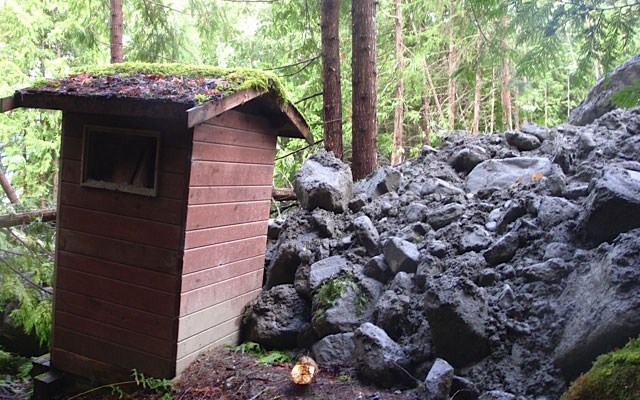Following a successful local area service petition last year, residents of the Lillooet Lake Estates (LLE) community southeast of Pemberton may soon see some long-awaited debris flow mitigation work taking place.
At its Dec. 14 meeting, the Squamish-Lillooet Regional District’s (SLRD) board of directors adopted bylaws that will create a local service area for the work, enabling the SLRD to borrow $4 million towards the project’s $9 million total price tag, to be repaid by affected property owners through their taxes.
Residents of LLE and neighbouring Heather Jean Properties, located about a half an hour southeast of Pemberton on the In-shuck-ch Forest Service Road on the shores of Lillooet Lake, are no strangers to landslides.
First established in 1976, the risk of landslides has been a constant issue for the 170 properties in the community (year-round population of about 60). Debris, particularly from Twin Goat Mountain, periodically flows down Catiline Creek, which cuts through the middle of the community, occasionally leading to dangerous landslides.
A decade ago, in 2013, a large-scale debris flow event resulted in 25,000 cubic metres of material deposited in the community, and an evacuation order being implemented for weeks while the government assessed the damage and ongoing risk.
The landslide risk has hung over the small lakeside community ever since.
The scale of the 2013 slide prompted the provincial government to commission a geotechnical report on the area. The results painted an expensive picture, with estimates for needed debris mitigation efforts ranging from $4 million for increasing the capacity of the existing channel to $31 million for a debris retention barrier on the creek’s fan that could handle up to 300,000-cubic-metre debris flows.
“We’ve had two major slides in 2010 or 2013 that didn’t hurt anybody, but they certainly created a real risk, and in one case, it destroyed a truck,” said Gary Young, president of the LLE strata.
For nearly a decade, the SLRD and the LLE strata have been developing solutions to help address the community’s landslide risks.
The work took a step forward on Dec. 14, as directors adopted new bylaws that established a local service area to design, construct, operate and maintain a debris flow mitigation structure for Catiline Creek, which will mitigate risk to the community.
Directors also approved a $4-million loan authorization to fund the work, which will substantially help improve the community’s safety once complete.
Residents approved the local service taxation area, with a substantial majority in favour. “We orchestrated a petition process, and we got 85 per cent, so it’s obvious that the community is totally behind getting this project fixed, getting the community safe, and letting us return to normal life,” Young said.
The service area establishment allows the SLRD to help the community take on some of the project’s cost over an extended period.
“In this case, they need a debris flow barrier to be built. It’s going to be very expensive, but it will allow these homes to build this without it taking 25 years to save the money. They can front-load it with a loan and then pay it back over time,” said SLRD chair Jen Ford.
The estimated cost for designing and constructing the debris flow mitigation structure and excavation work in Catiline Creek is about $9,024,233, of which $4 million is the amount of debt the SLRD will borrow to complete the project either entirely or in phases.
Of the $9 million, a portion of the total cost will be covered by the Ministry of Forests, Lands and Natural Resource Operation (MFLNRO), as it will have to replace a bridge on the forest service road that crosses the creek.
“It is about a $7-million project, or a little over $7 million plus the participation of [MFLNRO], because they have to do work on the forest service road,” Young said.
The completion timeline ranges from one to four years for the mitigation structure, including the timing of federal grant applications, permits and the need for fair-weather windows when excavation work begins on the creek.
Young believes with some of the landslide risks abated, the lakeside community’s property values will increase as the risk of damage reduces and more people will move to the community.
“It’s fair to say, and I think the province recognizes this, our land costs are depressed by the risk associated with Catiline Creek,” he said. “So once Catiline Creek is finished, I’m convinced we will see significantly more people moving here full-time.”




